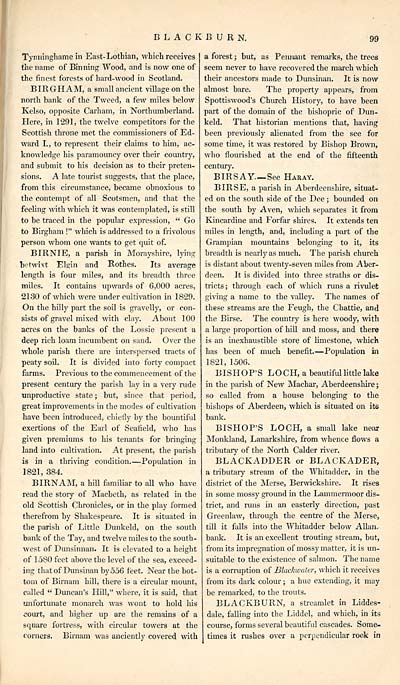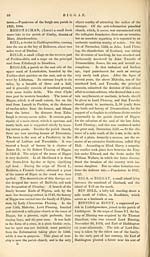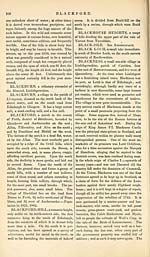Gazetteer of Scotland > Volume 1
(127) Page 99 - BIN
Download files
Complete book:
Individual page:
Thumbnail gallery: Grid view | List view

BLACKBURN.
99
Tymiinghame in East- Lothian, which receives
the name of Binning Wood, and is now one of
the finest forests of hard-wood in Scotland.
BIRGHAM, a small ancient village on the
north bank of the Tweed, a few miles below
Kelso, opposite Carham, in Northumberland.
Here, in 1291, the twelve competitors for the
Scottish throne met the commissioners of Ed-
ward I., to represent their claims to him, ac-
knowledge his paramouncy over their country,
and submit to his decision as to their preten-
sions. A late tourist suggests, that the place,
from this circumstance, became obnoxious to
the contempt of all Scotsmen, and that the
feeling with which it was contemplated, is still
to be traced in the popular expression, " Go
to Birgham !" which is addressed to a frivolous
person whom one wants to get quit of.
BIRNIE, a parish in Morayshire, lying
betwixt Elgin and Rothes. Its average
length is four miles, and its breadth three
miles. It contains upwards of 6,000 acres,
2130 of which were under cultivation in 1829.
On the hilly part the soil is gravelly, or con-
sists of gravel mixed with clay. About 100
acres on the banks of the Lossie present a
deep rich loam incumbent on sand. Over the
whole parish there are interspersed tracts of
peaty soil. It is divided into forty compact
farms. Previous to the commencement of the
present century the parish lay in a very rude
unproductive state ; but, since that period,
great improvements in the modes of cultivation
have been introduced, chiefly by the bountiful
exertions of the Earl of Seatield, who has
given premiums to his tenants for bringing
land into cultivation. At present, the parish
is in a thriving condition. — Population in
1821, 384.
BIRNAM, a hill familiar to all who have
read the story of Macbeth, as related in the
old Scottish Chronicles, or in the play formed
therefrom by Shakespeare. It is situated in
the parish of Little Dunkeld, on the south
bank of the Tay, and twelve miles to the south-
west of Dunsinnan. It is elevated to a height
of 1580 feet above the level of the sea, exceed-
ing that of Dunsinan by 556 feet. Near the bot-
tom of Birnam hill, there is a circular mount,
called " Duncan's Hill," where, it is said, that
unfortunate monarch was wont to hold his
-court, and higher up are the remains of a
square fortress, with circular towers at the
corners. Birnam was anciently covered with
a forest ; but, as Pennant remarks, the trees
seem never to have recovered the march which
their ancestors made to Dunsinan. It is now
almost bare. The property appears, from
Spottiswood's Church History, to have been
part of the domain of the bishopric of Dun-
keld. That historian mentions that, having
been previously alienated from the see for
some time, it was restored by Bishop Brown,
who flourished at the end of the fifteenth
century.
B IRS AY— See Haray.
BIRSE, a parish in Aberdeenshire, situat-
ed on the south side of the Dee ; bounded on
the south by Aven, which separates it from
Kincardine and Forfar shires. It extends ten
miles in length, and, including a part of the
Grampian mountains belonging to it, its
breadth is nearly as much. The parish church
is distant about twenty-seven miles from Aber-
deen. It is divided into three straths or dis-
tricts; through each of which runs a rivulet
giving a name to the valley. The names of
these streams are the Feugh, the Chattie, and
the Birse. The country is here woody, with
a large proportion of hill and moss, and there
is an inexhaustible store of limestone, which
has been of much benefit. — Population in
1821, 1506.
BISHOP'S LOCH, a beautiful little lake
in the parish of New Machar, Aberdeenshire ;
so called from a house belonging to the
bishops of Aberdeen, which is situated on its
bank.
BISHOP'S LOCH, a small lake near
Monkland, Lanarkshire, from whence flows a
tributary of the North Calder river.
BLACKADDER or BLACKADER,
a tributary stream of the Whitadder, in the
district of the Merse, Berwickshire. It rises
in some mossy ground in the Lammermoor dis-
trict, and runs in an easterly direction, past
Greenlaw, through the centre of the Merse,
till it falls into the Whitadder below Allan-
bank. It is an excellent trouting stream, but,
from its impregnation of mossy matter, it is un-
suitable to the existence of salmon. The name
is a corruption of Blachcater, which it receives
from its dark colour ; a hue extending, it may
be remarked, to the trouts.
BLACKBURN, a streamlet in Liddes-
dale, falling into the Liddel, and which, in its
course, forms several beautiful cascades. Some-
times it rushes over a perpendicular rook in
99
Tymiinghame in East- Lothian, which receives
the name of Binning Wood, and is now one of
the finest forests of hard-wood in Scotland.
BIRGHAM, a small ancient village on the
north bank of the Tweed, a few miles below
Kelso, opposite Carham, in Northumberland.
Here, in 1291, the twelve competitors for the
Scottish throne met the commissioners of Ed-
ward I., to represent their claims to him, ac-
knowledge his paramouncy over their country,
and submit to his decision as to their preten-
sions. A late tourist suggests, that the place,
from this circumstance, became obnoxious to
the contempt of all Scotsmen, and that the
feeling with which it was contemplated, is still
to be traced in the popular expression, " Go
to Birgham !" which is addressed to a frivolous
person whom one wants to get quit of.
BIRNIE, a parish in Morayshire, lying
betwixt Elgin and Rothes. Its average
length is four miles, and its breadth three
miles. It contains upwards of 6,000 acres,
2130 of which were under cultivation in 1829.
On the hilly part the soil is gravelly, or con-
sists of gravel mixed with clay. About 100
acres on the banks of the Lossie present a
deep rich loam incumbent on sand. Over the
whole parish there are interspersed tracts of
peaty soil. It is divided into forty compact
farms. Previous to the commencement of the
present century the parish lay in a very rude
unproductive state ; but, since that period,
great improvements in the modes of cultivation
have been introduced, chiefly by the bountiful
exertions of the Earl of Seatield, who has
given premiums to his tenants for bringing
land into cultivation. At present, the parish
is in a thriving condition. — Population in
1821, 384.
BIRNAM, a hill familiar to all who have
read the story of Macbeth, as related in the
old Scottish Chronicles, or in the play formed
therefrom by Shakespeare. It is situated in
the parish of Little Dunkeld, on the south
bank of the Tay, and twelve miles to the south-
west of Dunsinnan. It is elevated to a height
of 1580 feet above the level of the sea, exceed-
ing that of Dunsinan by 556 feet. Near the bot-
tom of Birnam hill, there is a circular mount,
called " Duncan's Hill," where, it is said, that
unfortunate monarch was wont to hold his
-court, and higher up are the remains of a
square fortress, with circular towers at the
corners. Birnam was anciently covered with
a forest ; but, as Pennant remarks, the trees
seem never to have recovered the march which
their ancestors made to Dunsinan. It is now
almost bare. The property appears, from
Spottiswood's Church History, to have been
part of the domain of the bishopric of Dun-
keld. That historian mentions that, having
been previously alienated from the see for
some time, it was restored by Bishop Brown,
who flourished at the end of the fifteenth
century.
B IRS AY— See Haray.
BIRSE, a parish in Aberdeenshire, situat-
ed on the south side of the Dee ; bounded on
the south by Aven, which separates it from
Kincardine and Forfar shires. It extends ten
miles in length, and, including a part of the
Grampian mountains belonging to it, its
breadth is nearly as much. The parish church
is distant about twenty-seven miles from Aber-
deen. It is divided into three straths or dis-
tricts; through each of which runs a rivulet
giving a name to the valley. The names of
these streams are the Feugh, the Chattie, and
the Birse. The country is here woody, with
a large proportion of hill and moss, and there
is an inexhaustible store of limestone, which
has been of much benefit. — Population in
1821, 1506.
BISHOP'S LOCH, a beautiful little lake
in the parish of New Machar, Aberdeenshire ;
so called from a house belonging to the
bishops of Aberdeen, which is situated on its
bank.
BISHOP'S LOCH, a small lake near
Monkland, Lanarkshire, from whence flows a
tributary of the North Calder river.
BLACKADDER or BLACKADER,
a tributary stream of the Whitadder, in the
district of the Merse, Berwickshire. It rises
in some mossy ground in the Lammermoor dis-
trict, and runs in an easterly direction, past
Greenlaw, through the centre of the Merse,
till it falls into the Whitadder below Allan-
bank. It is an excellent trouting stream, but,
from its impregnation of mossy matter, it is un-
suitable to the existence of salmon. The name
is a corruption of Blachcater, which it receives
from its dark colour ; a hue extending, it may
be remarked, to the trouts.
BLACKBURN, a streamlet in Liddes-
dale, falling into the Liddel, and which, in its
course, forms several beautiful cascades. Some-
times it rushes over a perpendicular rook in
Set display mode to: Large image | Transcription
Images and transcriptions on this page, including medium image downloads, may be used under the Creative Commons Attribution 4.0 International Licence unless otherwise stated. ![]()
| Gazetteers of Scotland, 1803-1901 > Gazetteer of Scotland > Volume 1 > (127) Page 99 - BIN |
|---|
| Permanent URL | https://digital.nls.uk/97425886 |
|---|
| Description | Volume I: Abbey to Glenartney. |
|---|---|
| Attribution and copyright: |
|
| Description | By Robert Chambers and William Chambers. Glasgow: Blackie & Son, 1838. 2 volumes. |
|---|---|
| Shelfmark | NF.1461.g.7 |
| Additional NLS resources: | |

